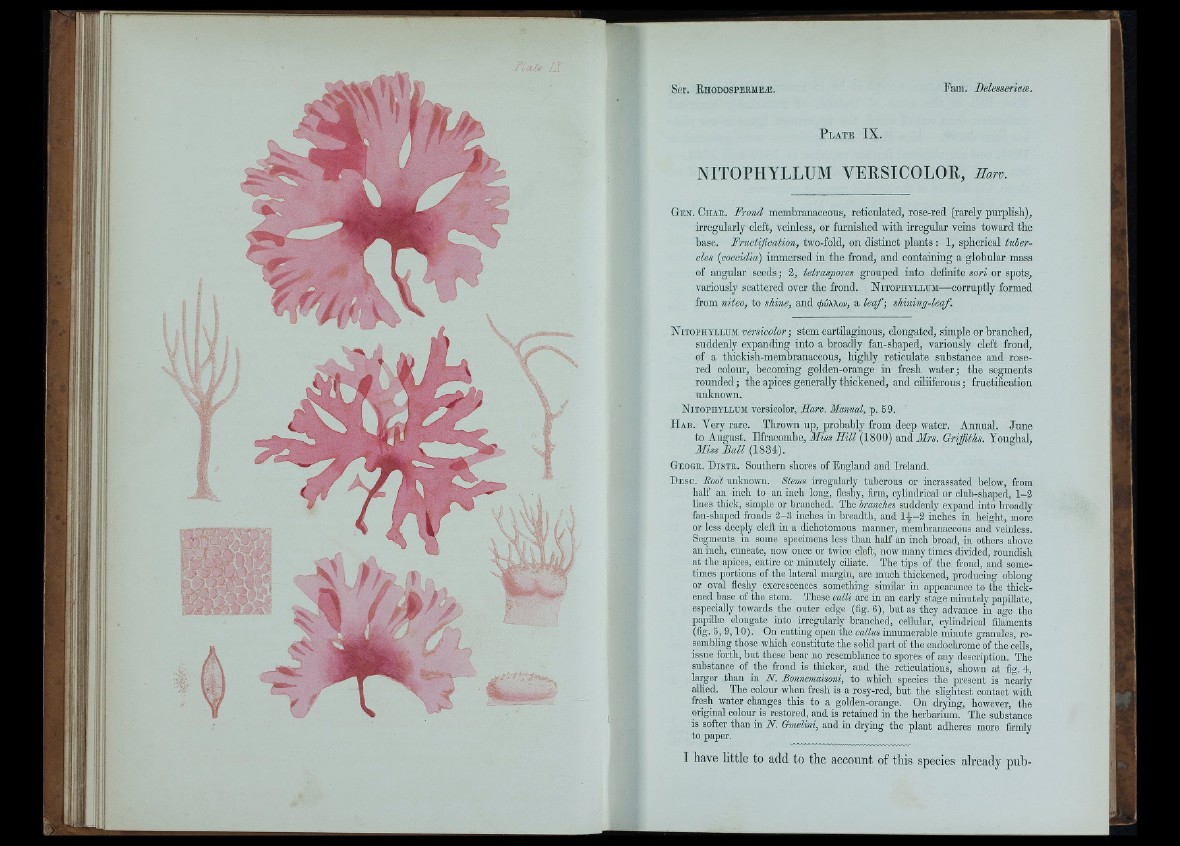
P la t e IX.
NITOPHYLLUM VERSICOLOR, Harv.
Gen. C h a r . Frond membranaoeons, reticulated, rose-red (rarely purplish),
irregularly cleft, veinless, or furnished with irregular veins toward the
base. Frnetification, two-fold, on distinct plants ; 1, spherical tubercles
{coccidia) immersed in the frond, and containing a globular mass
of angular seeds ; 3, tetraspores grouped into definite sori or spots,
variously scattered over the frond. N it o ph y l l t im—corruptly formed
from niteo, to shine, and <f>vXKov, a leaf-, shining-leaf
N it o ph y l l u m versicolor ; stem cartilaginous, elongated, simple or branched,
suddenly expanding into a broadly fan-shaped, variously cleft frond,
of a thiokish-membraiiaceous, higlily reticulate substance and rose-
red colour, becoming golden-orange in fresh water; the segments
rounded ; the apices generaUy thickened, and cihiferous ; fructification
unknown.
N it o ph y l l u m v e rsico lo r, Harv. Manual, p . 5 9 .
H ab. Yery rare. Tluown up, probably from deep water. Annual. June
to August. Ilfracombe, Miss H ill (1800) and Mrs. Griffiths. Youghal,
Miss B a ll (1834).
G l o g r . D is t b . Southern shores of England and Ireland.
D e s c . Root unknown. Stems irregularly tuberous or incrassated below, from
lialf an inch to an inch long, fleshy, &m, cylindrical or club-shaped, 1 -2
lines thick, simple or branched. The branches suddenly expand into broadly
fan-shaped fronds 2-3 inches in breadth, and I i - 2 inches in height, more
or less deeply cleft in a dichotomous manner, membranaceous and veinless.
Segments in some specimens less than half an inch broad, in others above
ail inch, cuneate, now once or twice cleft, now many times divided, roundish
at the apices, entire or minutely ciliate. The tips of the frond, and sometimes
portions of the lateral margin, are much thickened, producing oblong
or oval fleshy excrescences something similar in appearance to the thickened
base of the stem. These calli are in an early stage minutely papillate,
especially towards the outer edge (fig. 6), but as they advance in age thé
papülæ elongate into irregularly branched, cellular, cylindrical filaments
(fig. 5, 9,10). On cutting open the callus innumerable minute granules, resembling
those which constitute the solid part of the endochrome of the cells,
issue forth, but these bear no resemblance to spores of any description. The
substance of the frond is tliicker, and the reticulations, shown at fig. 4,
larger than in N. Bonnemaisoni, to which species the present is nearly
allied. The colom- when fresh is a rosy-red, but the slightest contact with
fresh water changes this to a golden-orange. On di-ying, however, the
original colour is restored, and is retained in the herbarium. The substance
is softer than in N . Gmelini, and in drying the plant adheres more firmly
to paper.
I have little to add to the account of this species already pub